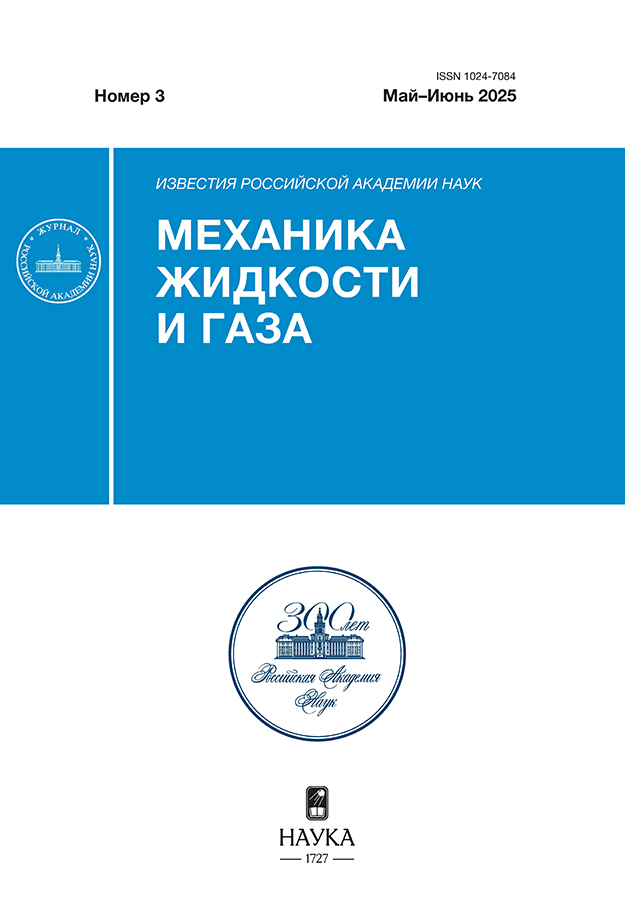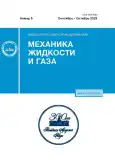Effect of Cavitator and Nozzle Parameters on the Efficiency job of the impulse Jet Generator
- Authors: Ocheretanyi S.A.1, Prokof’ev V.V.1
-
Affiliations:
- Moscow State University named after M.V. Lomonosov, Research Institute of Mechanics
- Issue: No 5 (2023)
- Pages: 10-24
- Section: Articles
- URL: https://journals.rcsi.science/1024-7084/article/view/135077
- DOI: https://doi.org/10.31857/S1024708422600981
- EDN: https://elibrary.ru/OGFLMM
- ID: 135077
Cite item
Full Text
Abstract
Studies of fluid jet flows in the presence of a ventilated cavity with a negative cavitation number, carried out at the Institute of Mechanics of Moscow State University, showed that under certain conditions, self-cavitational oscillations with a high intensity of pressure pulsations occur in such a hydraulic system. It was shown that it is possible in principle to use the self-oscillation regime to create periodic impulsed jets during outflow from a converging nozzle into the atmosphere. The influence of the parameters of the cavitator and the outlet nozzle on the intensity of the impact of the outflowing liquid on the screen located perpendicular to the outflow direction is studied. It is shown that an increase in the length of the nozzle can significantly increase the efficiency of the generator, and a smooth narrowing of the channel in front of the cavitator can increase the operating range of the generator in the direction of larger gas blows. It is shown that there is a scale effect - with increasing head pressure, the relative intensity of self-oscillations decreases, but tends to reach a horizontal asymptote.
About the authors
S. A. Ocheretanyi
Moscow State University named after M.V. Lomonosov, Research Institute of Mechanics
Email: ocheret@imec.msu.ru
Moscow, Russia
V. V. Prokof’ev
Moscow State University named after M.V. Lomonosov, Research Institute of Mechanics
Author for correspondence.
Email: vlad.prokof@yandex.ru
Moscow, Russia
References
- Козлов И.И., Прокофьев В.В. Закономерности развития волн на поверхности каверны с отрицательным числом кавитации // Доклады РАН. 2006. Т. 409. № 1. С. 43–47.
- Козлов И.И., Очеретяный С.А., Прокофьев В.В. Автоколебательные режимы в жидкой струйной завесе, разделяющей газовые области с различными давлениями // Изв. РАН МЖГ. 2013. № 6. С. 33–43.
- Очеретяный С.А., Прокофьев В.В. Влияние сужения сопла на работу генератора периодических импульсных струй // Изв. РАН МЖГ. 2022. № 2. С. 14–26.
- Семко А.Н. Импульсные струи жидкости высокой скорости и их применение: монография / Под общ. ред. А.Н. Семко. Донецк: ДонНУ. 2014. 370 с.
- Atanov G.A., Semko A.N. Numerical Analysis of the Jet Flows of Compressible Water // Proc. of International Summer Scientific School “High Speed Hidrodynamics”. June 2004, Cheboksary. Computational Publications. Russia. 2004. P. 39–44.
- Савченко Н.В., Яхно О.М. Гидродинамические способы создания пульсирующих струй для гидроразрушения твердых материалов // Вестник Сумского гос. ун-та. Сер. Технические науки. 2003. № 12 (58). С. 92–98.
- Шкапов П.М., Благовещенский И.Г., Гартиг Е.Б., Дорошенко С.А. О гистерезисном характере развития автоколебаний в гидролинии с ограниченной искусственной газовой каверной на выходе // Наука и образование. Электронное науч.-техн. изд. МГТУ им. Н.Э. Баумана. 2013. № 10. С. 1–10.
- Прокофьев В.В., Очеретяный С.А., Яковлев Е.А. Использование кавитационных автоколебательных режимов для генерации периодических импульсных струй // ПМТФ. 2021. Т. 62. № 1. С. 97–108.
- Идельчик И.Е. Справочник по гидравлическим сопротивлениям / Под ред. И.Е. Идельчик. М.–Л.: Госэнергоиздат, 1960. 464 с.
Supplementary files

























